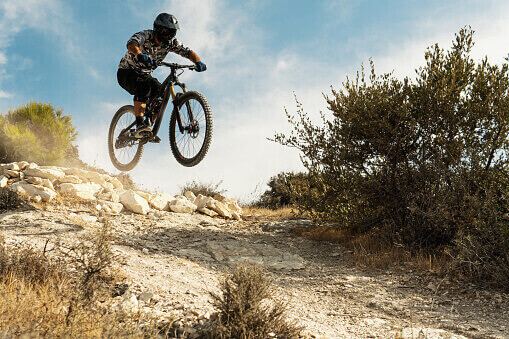Do you love mountain biking? The extreme adrenaline rush you get while trailing off-road is one of the best experiences ever.
There are over 40 million regular mountain biking participants in the U.S. alone and the number keeps growing every year!
Well, if you’re looking to become a mountain biking enthusiast then you’re at the right place. Here is a comprehensive guide for mountain bike buyers and everything you’d need to know before buying one.
Meet the Mountain Bike
The trend first began in the early 1980s with the earliest prototype of MTBs. Ever since it caught on among cycling enthusiasts, mountain biking became one of the most undertaken outdoor activities in the US. Since then, the level has risen up in terms of MTB trails, MTB bikes, technology, speed, and adventure. Today, it is one of the most popular outdoor sporting activities around the world.
To meet the emerging needs of MTB riders for speed and lightness, manufacturers started investing in making the bike lighter than ever and stronger than before. Thanks to the technology, bike manufacturers have started producing ultimate mountain beasts which can get you up to the top speed of 21 kph (13mph) which is 7 kph higher than any traditional MTBs.
Many newbie cyclists wonder if they should invest $$$$ on their first MTB or just buy a basic yet durable mountain bike for a start. We recommend that you should look into the features more than the price. Many cyclists feel that buying the all-carbon frame bike is the best option, but it isn’t so. A carbon frame bike absorbs a lot of vibration on rocky terrain than alloy-frame bikes, especially when you’re riding downhill.
E-bikes are becoming the new trend for both commuters and sportsmen. Many cycling enthusiasts have switched from non-assisted bikes (regular bikes) to e-bikes mainly for ease and affordable cost. You can easily get an e-bike by paying 40-50% more.
How Does an MTB Work?
MTBs work very differently from other bikes. They’re designed to incorporate features aimed at increasing durability and improving performance in difficult terrain. MTB has more gears than normal road bikes. With a road bike, you’d get 7 gears at most, but with MTB you’d get more than 11 different gears depending on the terrain. These gears are lower ratio gears to facilitate climbing steep hills and obstacles.
Most modern mountain bikes have some kind of suspension, 26, 27.5, or 29-inch diameter tires, usually between 1.7 and 2.5 inches in width. The frame incorporates a wider, flat, or upwardly-rising handlebar that allows a more upright riding position. This offers the rider more control and comfort.
MTBs have a smaller, reinforced frame, usually made of wide tubing to allow maximum body reach and control. Tires usually are mounted on rims for strength.
Compared to other road bikes, mountain bikes frequently use hydraulic disc brakes for quicker braking. Pedal designs may vary from simple platform pedals to clipless. Clipless pedals use a specially equipped shoe with a cleat that engages mechanically into the pedal.
Types of Mountain Bike
You can take up mountain biking for different activities. Some of the most common mountain bike types include Cross Country (XC), Trail, All Mountain (Enduro), and Downhill (DH).
Cross Country (XC)
Cross country or XC biking is very popular among the riders. The XC bikes are built for riders who want pedaling performance as their top priority. The geometry of XC bikes is most similar to road bikes. They are focused on efficiency and lightweight design.
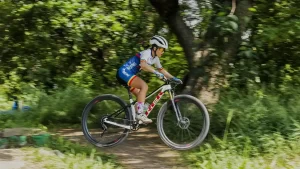
Cross country mountain bikes are great for long miles pedaling and uphill climbing. Some of the features include:
- They use the largest mountain bike wheel size, 29″.
- They’re ultra-lightweight, often less than 24 pounds, with 4.7″/120mm or less of travel.
- Hardtails are used for front suspension only
- Tires with reduced weight and faster rolling resistance are preferred over traction and control
Trail Mountain Bikes
Trail mountain bike is the commonest form of mountain bike type. They’re used for both climbing and downhill rides. They’re meant for less riding and more technical single tracks either up or down.
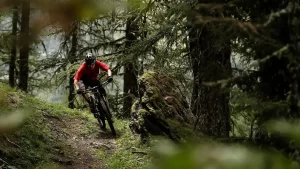
Some of the features include:
- Trail bikes enjoy a wheel size of 27.5″ to 29″.
- The suspension remains anywhere between 4.7″/120mm to 6″/150mm of travel.
- They have a more relaxed geometry than their XC. Trail bike geometry is neutral and the head angle is 66° or 68°.
Enduro/All-Mountain

Enduro or All Mountain basically means riding in the mountains. The Enduro bikes are compact and built for durability with good traction. The bikes are light with wide tires to support both uphill and downhill climbs. Some of the features include:
- The wheels are 27.5″ or 29″. Most even use mixed sizes like 29″ in the front and 27.5″ in the rear.
- They have more suspension travel than trail bikes, ranging from 5.5″/140mm to 6.7″/180mm.
- The geometry is designed for descending over climbing.
- It has a long wheelbase and reaches.
- Tires are designed for aggressive knobs for cornering and traction.
Downhill
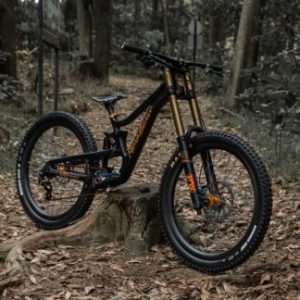
As the term suggests, “Downhill bike” is designed for steep downhill, speed, big drops, and jumps. They’re solely designed for a downhill hike so the build is designed to withstand strong force. Some of the features include:
- It sports burly frames 6.7″/170mm – 10″/250mm + suspension in the rear and 7″/180mm – 8″/200mm in the front. The front frame has dual-crown forks
- It has less than 65 head angles and holds a very low center o gravity.
- The tires are designed for traction and durability with 2-ply (double-thick) casings.
Hardtail vs. Full-Suspension
The type of mountain bike is defined by the type and number of suspensions it uses. Generally, it’s divided into two different types
- Hardtail
- Suspension
A hardtail is a bike with no rear suspension. It only has a suspension fork. It’s one of the most popular types of mountain bikes and is mostly used for all-around riding and cross-country.
The suspension is a bike with front and rear suspension. It has both a suspension fork up front and a rear shock. It’s best for downhill riding and jumping. These types of bikes require a high level of maintenance.
Why choose a Hardtail bike?
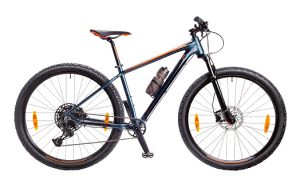
- If you’re on a budget. Hardtail is an all-rounder bike that you can get for less than $1500. The simpler design and high-end components make it affordable.
- If you mostly ride smooth trails then a hardtail is the best bike for you.
- A hardtail requires low maintenance and is cheaper than maintaining full-suspension bikes.
- Because of a simpler design, a hardtail weighs less.
Why choose a full-suspension bike?
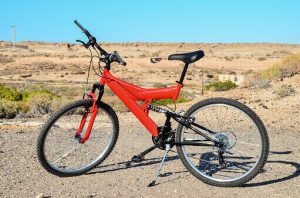
- If you’re willing to pay more. High-quality, entry-level full-suspension bikes start at $1500 and go up.
- If you mostly ride technical trails such as rocky terrain, uphill, and downhill.
- A full-suspension bike helps to absorb and eliminate bumps and vibration.
- They’re good for higher speed because of less drag and vibration.
Mountain Bike Discipline
The mountain bike discipline correlates to the mountain bike types. Each discipline requires a certain type of MTB. There are 5 different types of biking disciplines namely Cross country, All-mountain, Downhill, Dirt Jump, and Freeride.
Let’s explain the three most famous and undertaken MTB disciplines.
Cross-Country
Cross country or XS is defined by long hours of riding. it doesn’t usually involve extreme or difficult obstacles such as significant rocky terrain or steep downhill. However, it may incorporate different kinds of trails such as mud, gravel, asphalt, rocks, etc.
The XC riders require a high level of endurance fitness and handling skill. The MTB chosen for this track is a short-travel hardtail and full-suspension with 120mm of travel.
Downhill
As the term suggests, downhill is a steep downhill ride that usually follows a straight trail through the mountain terrain. It’s one of the most difficult biking disciplines that require sheer confidence and speed. The rider may face really rough tracks of the mountain along with constant jumps and rocks.
Modern Enduro bikes are basically downhill bikes. They usually have 150-170mm of travel and full suspension. The rider must wear full gear including a full-face helmet and pads for protection. The Enduro bikes are one of the strongest MTBs.
Trail Riding
This is a more aggressive type of XC riding with more technical tracks such as uphill and downhill. It requires a full-suspension or hardtail bike with around 120mm-130mm of travel. It can be of any length, including a long-distance and a multi-day trip. The trail riders avoid asphalt roads and take up off-beat trails such as forest paths, gravel, etc.
Why Mountain Bike?
Adrenaline Rush, Complete Cardio, and Adventure! Biking is a complete cardio workout. You’ll burn about 400 calories an hour. Plus, extreme adrenaline rushes and adventure! Mountain biking is one of the best experiences to enjoy sceneries while getting fit.
Health Benefits
MTB is loaded up with a lot of health benefits. Depending on the trail, mountain biking burns between 600 – 1,000 calories per hour. You’re sure to lose extra pounds and maintain your weight. Continuous riding, it’s sure to increase muscle strength, improve cardiovascular health, build endurance. Biking for just two to three hours a week is linked to improved lung capacity and oxygen intake. It also helps to sharpen your concentration.
Ease of Riding
With the right mountain bike, you can enjoy both short and long-distance rides. They are great for cross-country tours and can go over any kind of terrain. The cushy seat, upright seating position, compact geometry, and light body make the road beast. Compared to all the road bikes, mountain bikes offer ease of riding as you can choose from hardtail to full-suspension frame that ensures the utmost comfort.
Best of Both Worlds
Mountain bikes combine the best of both worlds i.e. adventure riding and commute. As we all know, bikes are a great alternative to gas-powered vehicles. Mountain bikes combine the agility and speed of gas-powered vehicles and at the same time offer a chance to exercise. You aren’t only investing in the adrenaline rush but also combining physical and mental wellbeing.
Great for Hills
Mountain bikes are the ultimate beast for the hilly terrain. The compact and light body, big and flat wheels, and full suspension can counter any kind of hilly terrain. The high speeds and gears help to climb up or down on any steep terrain. If you think about it, mountain bikes are the ultimate mode of commute.
MTB Price
The price of a mountain bike depends on a lot of different factors including a frame, suspension, gearing, discipline, and brand.
Although you can find a mountain bike as low as $800, if you’re looking to hit the hard trails, you must start considering investing in a mountain bike with better components.
To start with the minimum prices, we recommend choosing a Hardtail for no less than $1,500 and a full suspension at $2,000 to $2,500. You can get branded mountain bikes with quality components at this price. The problem is that most of the components or frame in this bike isn’t long-lasting. They require frequent maintenance and changes.
You can certainly purchase bikes lesser than $1000, but you must forgo the quality. If you’re looking for the absolute best, you can start looking for MTB starting between $4500 and $6000. The price may begin to rise as you start to add more components or customize the bike to meet certain needs.
If you’re willing to pay 30%-40% more on top, you can get yourself a great electronic mountain bike. These are the ultimate electronic beasts that get you farther with less effort.
Design Factors
While purchasing a mountain bike, we must look into different design factors. The price and durability may entirely depend on its design and components.
Wheel Size
Most mountain bikes are fitted with mostly two wheel sizes: 27.5˝ (also known as 650b) and 29˝ (called 29ers). The shorter wheel size such as the traditional 26˝ wheel is reserved for dirt jump and freeride. The measurements are generally mentioned as 29 x 2.0, 27.5 x 2.4, 29 x 2.8). For most MBTs, 29˝ wheels are the most efficient choice for most bikers mainly because large wheels are able to retain more speed than smaller wheels due to rotational inertia.
Gears
Mountain bikes generally start with 11 Gears. The modern MTB has a single chainring. The 11 gears are most preferred because they’re simpler, lighter, and quieter.
With a single chainring, it’s easier to maintain and repair it. With a single chainring, you can reply to shifting the gear using the right side of the handlebar. This frees up space in the left handlebar.
Frame
The mountain bike frame generally comes in aluminum (alloy), steel, or carbon. Most bikes are made out of alloy which keeps their price to the minimum. Many MTB frames are often combined with two different frames i.e. carbon and steel. The body could be made up of steel while the handlebars are made out of carbon. The price of the MTB depends on the frame type. All-carbon fiber bikes tend to be more expensive than alloy or steel bikes.
When it comes to durability, the alloy frames are prone to develop micro-cracks and weakness. Steel on the other hand could retain its strength and position despite being pliable. Steel is good when it comes to absorbing and minimizing the vibration compared to both alloy and carbon frames.
Style
Mountain biking style or discipline may determine the design of the MTB. A cross-country bike requires a hardtail bike with fewer gears while Enduro and downhill bike requires full suspension with more gears for effective control and handling.
The engineers focus on designing mountain bikes for specific purposes such as cross-country, downhill, endure, dirt biking, etc.
